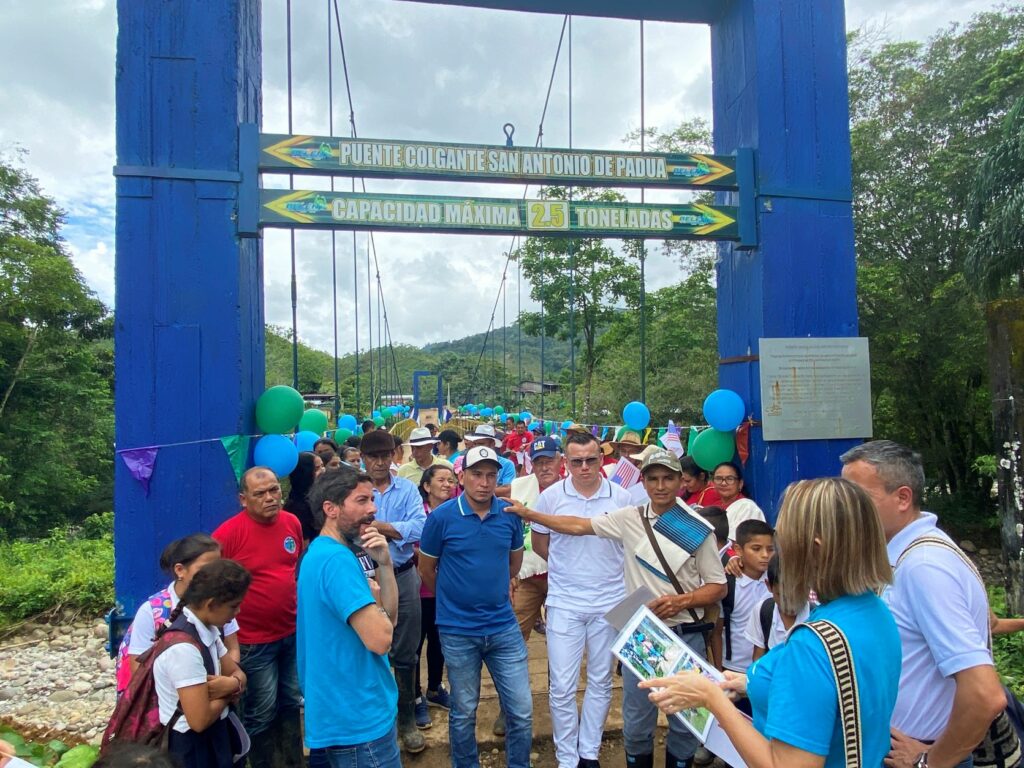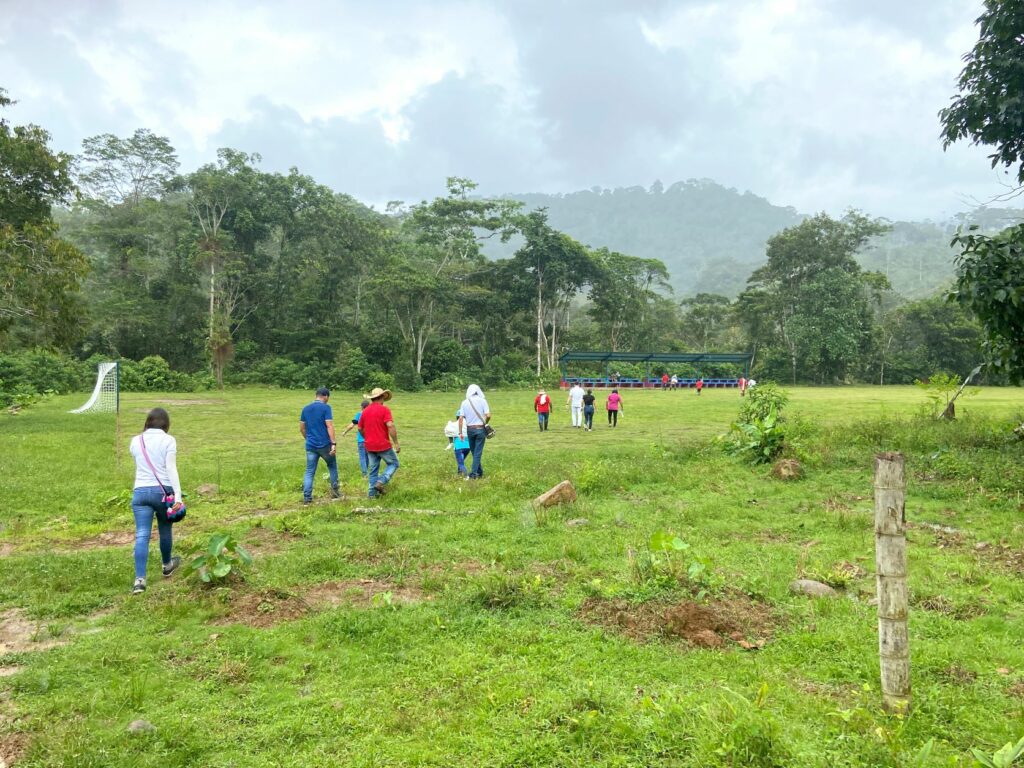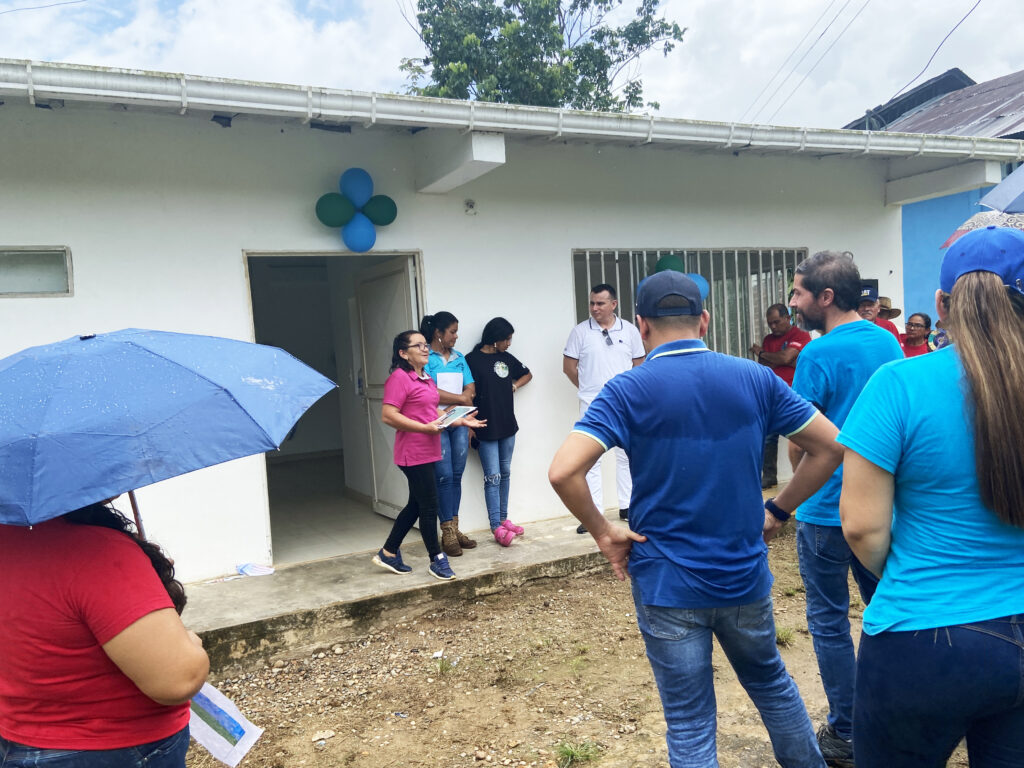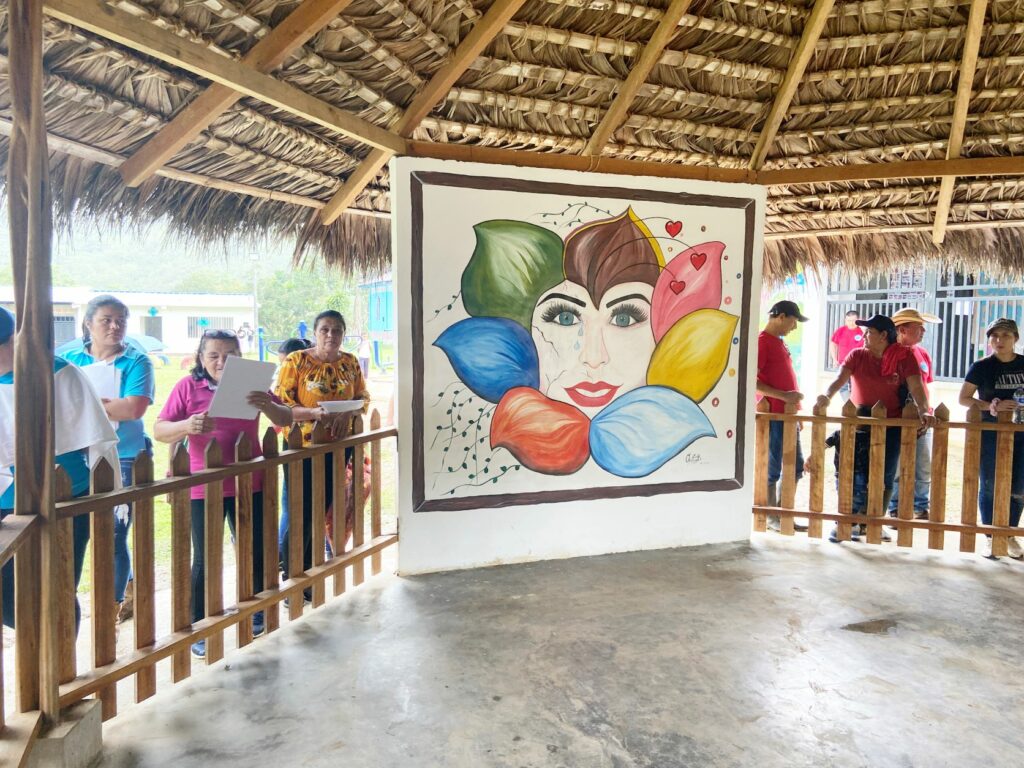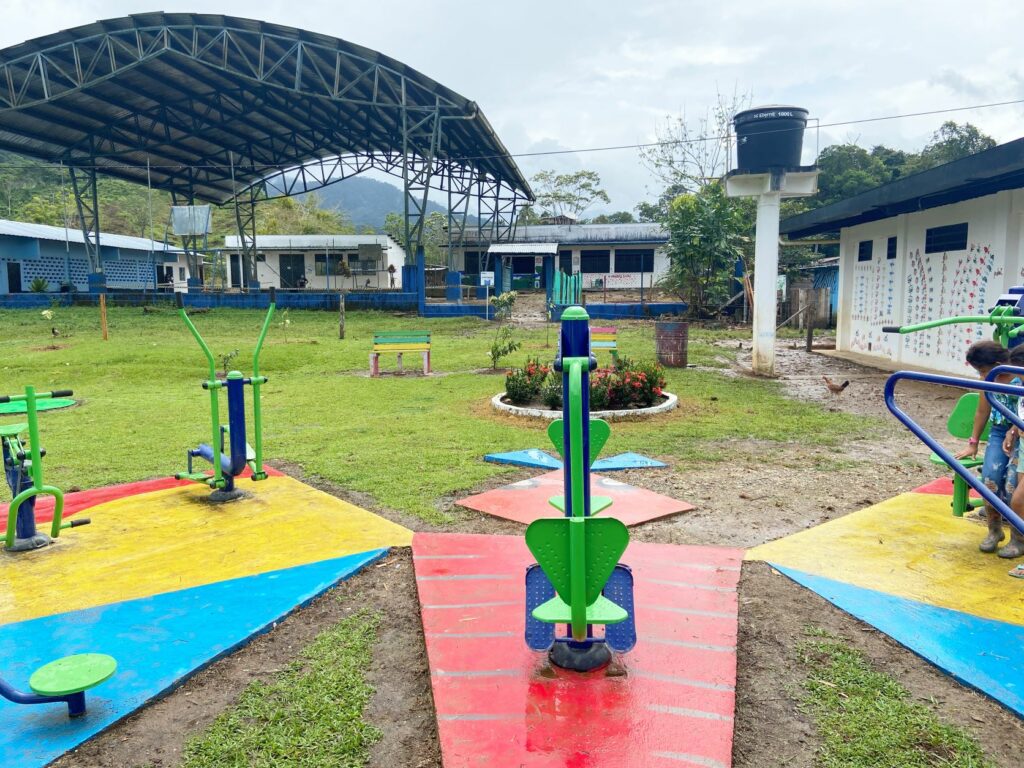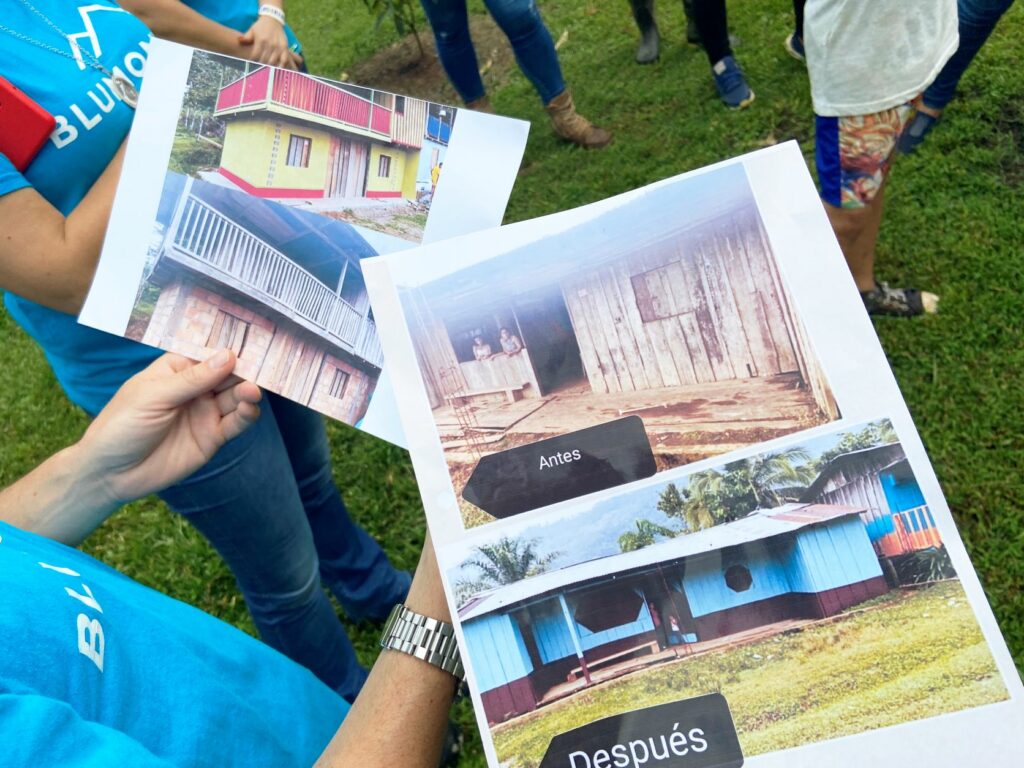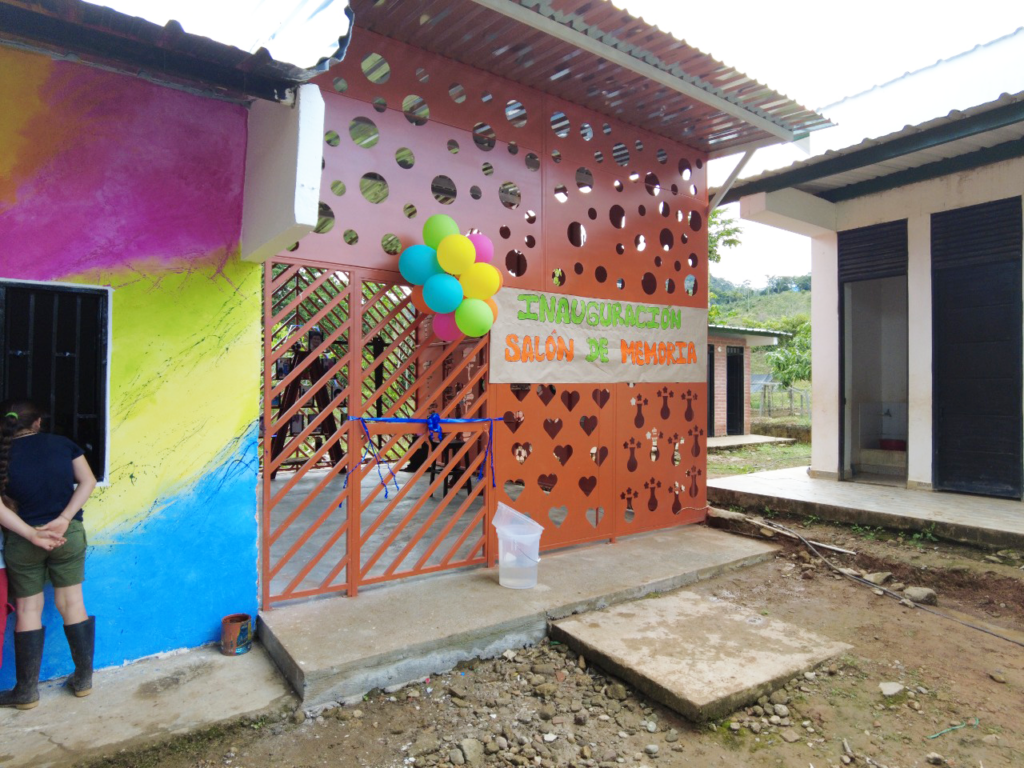San Antonio de Padua, nestled in the mountains of Caquetá, Colombia, is two hours from the closest urban center in Belen de los Andaquies and is only accessible by a brand-new suspension bridge built over a gushing river. When we began our peacebuilding work in San Antonio in 2019, the original bridge was precarious and too narrow for cars, and the town was reeling from years of local conflict, displacement, and loss.
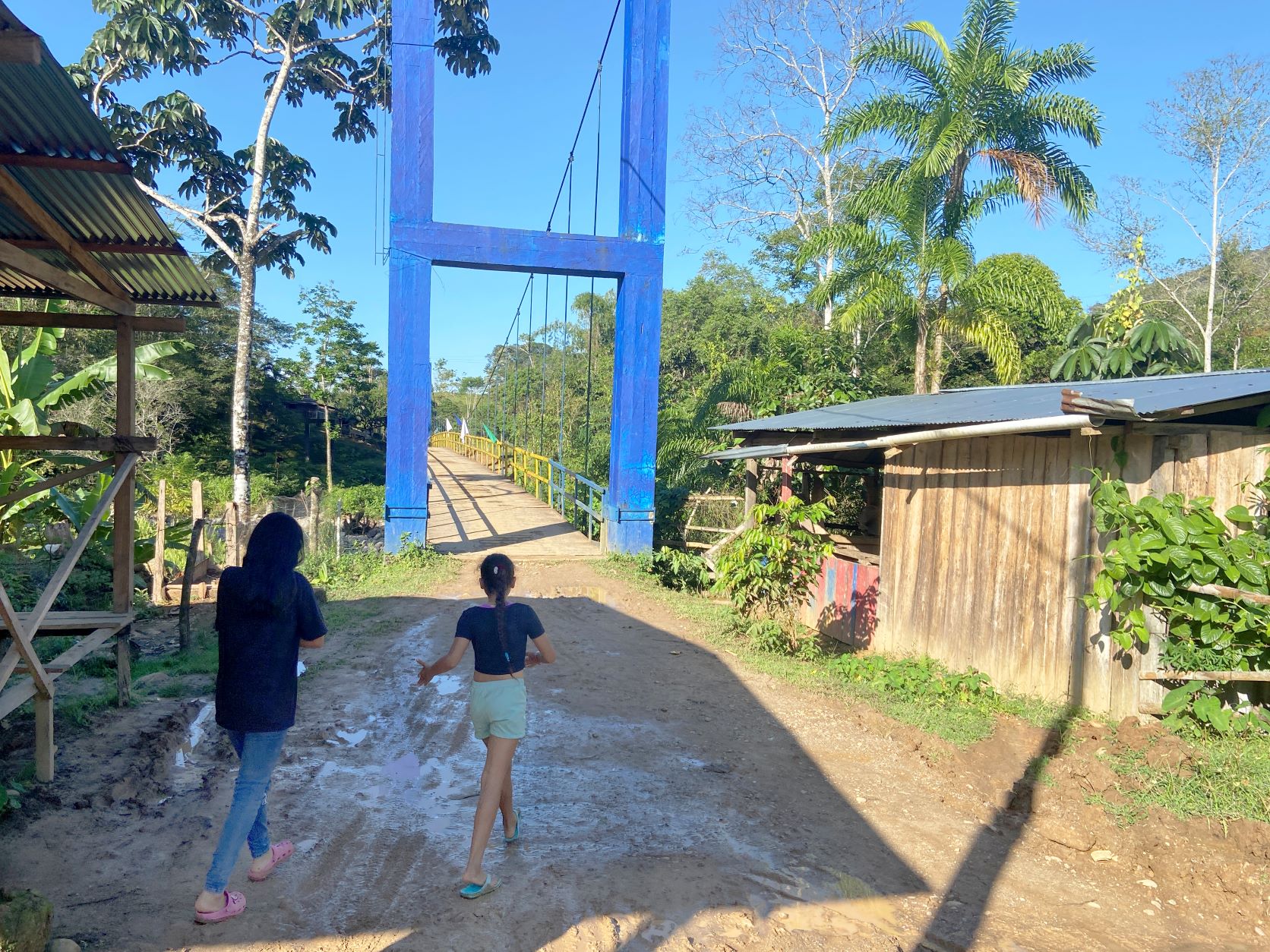
The bridge to San Antonio de Padua was rebuilt as a symbol of the transformation of the community.
Our Closing Gaps team has been working in San Antonio de Padua to promote emotional recovery and rebuild community connections with support from USAID’s Bureau for Humanitarian Assistance and the U.S. Department of State’s Bureau of Population, Refugees, and Migration. Paired with Blumont’s team of psychologists and an engineer, the community started its self-healing and peacebuilding process, closely aligned with psychosocial components of the Colombian peace agreement.
Collaborations to reimagine important community infrastructure like the bridge to San Antonio are part of our work to catalyze change and healing. The Closing Gaps recovery process primarily involves a community rehabilitation plan, activities like mutual support groups, and engagement with the local community action board (a neighborhood-level council) that lead to these collaborations.
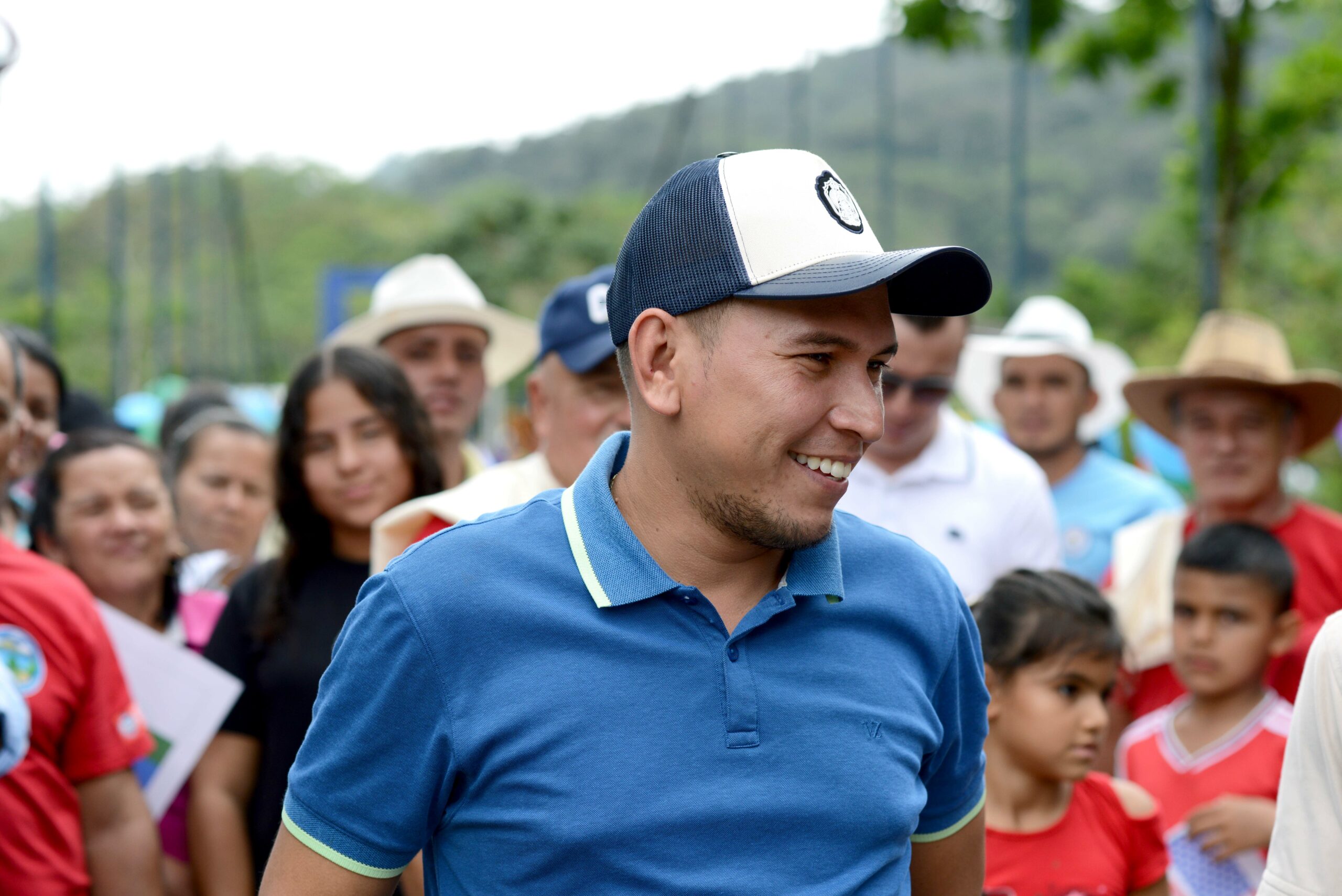
The mayor of Belen de los Andaquies, Tomas Rosero Barrera, standing on the bridge that connects the town to the rest of his jurisdiction, said, “we were divided before, but now we are united as a community.”
The mutual support groups, led by Blumont psychologists, are designed to help people recognize the pain and trauma they have felt and work through difficult experiences. The mutual support groups bring to life the “Emotional recovery measures at individual level” objective of the peace agreement, which aims “to broaden the public coverage and regional scope and improve the quality of psychosocial care to ensure the emotional recovery of victims in accordance with the specific harm or injury they have suffered.”
During years of conflict, trauma was widespread in San Antonio de Padua. Up to 20 percent of households were displaced at one point due to violence. Every resident knew of the many community members who had disappeared or been killed. By participating in the 12-session mutual support groups, people in San Antonio de Padua not only supported each other through psychosocial healing, but also built important friendships and shared memories that brought them together as a community.
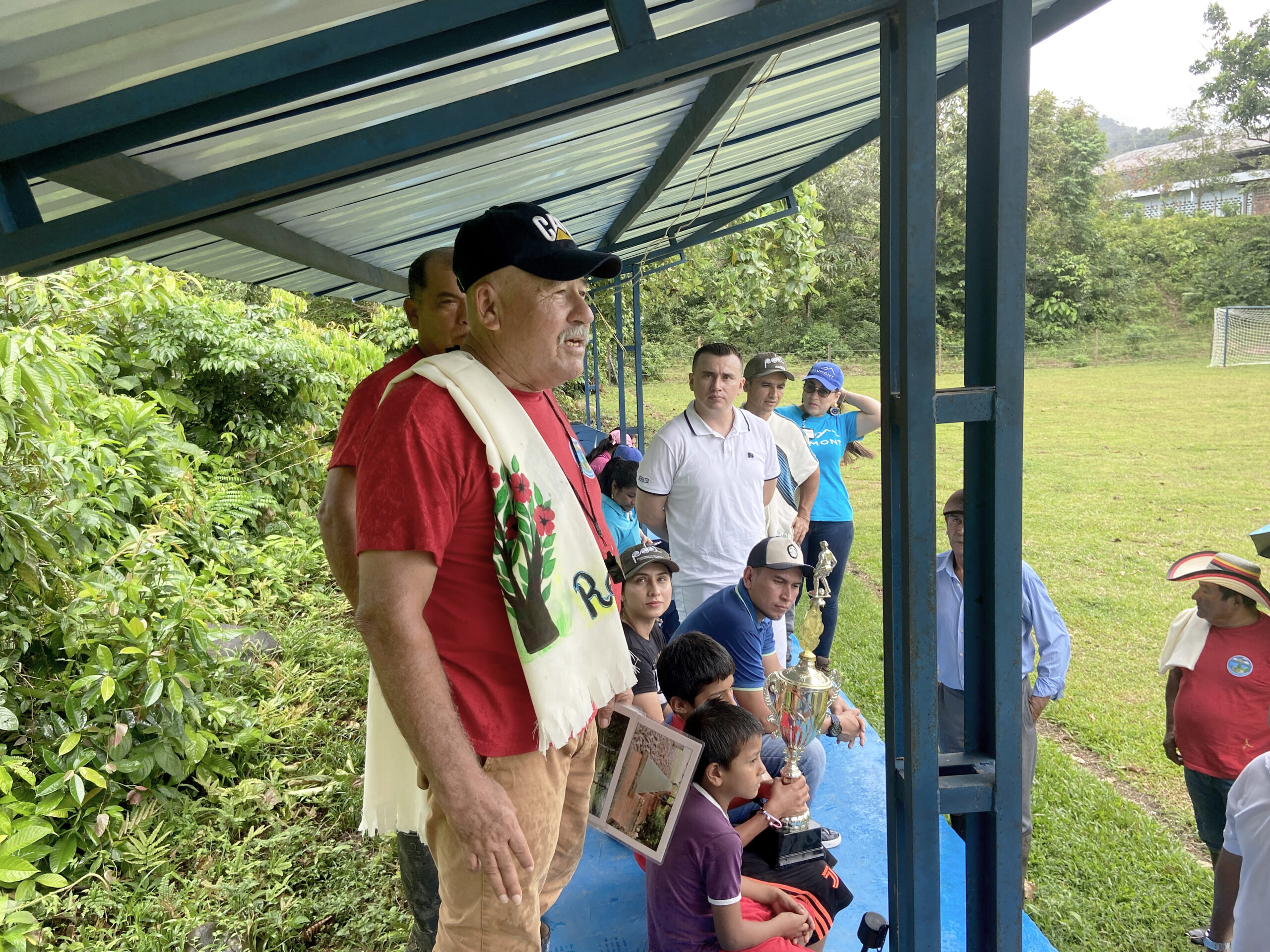
Reinaldo, a town elder and sports coach, said of the new soccer field: “It’s a future for us, for them, to teach them to work hard. “
Throughout our time in San Antonio de Padua, our team worked with the residents to develop a community action plan. The plan is a collaborative process that strengthens relations and heals social wounds through community-based actions and projects. In many plans, the community not only chooses to improve critical neighborhood facilities, but also to paint homes and create meaningful spaces that give community members a sense of ownership and pride while overwriting painful memories.
Blumont also engaged with the community action board, a longstanding group of local leaders who work together to solve important issues that help the community move forward. Hand-in-hand, the rehabilitation plan and the action board align with the peace agreement’s “Psychosocial rehabilitation plan for coexistence and non-recurrence” objective, working towards the goal “to increase the coverage and raise the quality of community rehabilitation strategies to rebuild the social fabric. These strategies will be developed through medium and long-term community processes whose key aims are to generate future projects for living together, build confidence among citizens and institutions and achieve peaceful coexistence within communities.” In San Antonio, the community action board has helped socialize and inform the community about important projects that the community has chosen for the community rehabilitation plan.
This journey that San Antonio de Padua took – through the community rehabilitation plan (including the mutual support groups and other activities) and community action board engagement – has led to a physical and emotional transformation that remembers a shared history while creating a new, promising future. To fully understand the transformation, all it takes is a walk through the town to see the thoughtfully repaired bridge, soccer field, health clinic, women’s meeting space, playground, painted homes (Casa Pintada), and memory sanctuary. As each place was rehabilitated, the community’s social fabric continued to mend.
San Antonio de Padua’s Peacebuilding Journey
Click on the arrows below to view each community project
- Bridge: This bridge stands at the entrance of San Antonio de Padua in the tropical mountains of Caquetá. This bridge – newly inaugurated during the pandemic – replaced a precarious wooden plank walkway over a gushing river that had served as the only way into the town for decades. The bridge is a symbol of the physical transformations in San Antonio that have changed the town’s trajectory and mark its new beginning. The president of the community action board, Luis (right), said, “This story of a difficult situation has ended happily. It’s so valuable what every person and every family has learned throughout this process.”
- Soccer field: Children in San Antonio play in a large soccer field bordered by concrete and metal risers for spectators on one side. When the daily rains come, the team can retreat to the new risers and take cover under the roof. Before Blumont’s intervention, this land was dangerous, uneven, and held gruesome memories of violence. Inocencia, a town elder, said of the new field, “This is an inspiration for us because it’s a recreation center where everyone can come to play and be a community.”
- Health clinic: Through Closing Gaps, the town’s only health clinic was renovated and outfitted with new equipment and supplies. Ofelia (center) has been the clinic’s nurse for more than 20 years and was born in San Antonio. At one point, during the town’s darkest times, it was also the local jail. “It was so hard to see people hurt,” she said, thinking back to when the clinic lacked the supplies to treat her neighbors, “but now seeing this clinic makes me happy.” Once unable to take in the sick and the injured, the clinic is now a safe haven and a place of healing for the town’s residents.
- Women’s meeting space: As part of the mutual support group’s process to heal the trauma of years of conflict and displacement, the women needed a space that was uniquely their own to share their stories and feelings. Blumont engineered an outdoor kiosk for the women, and a local artist painted a mural representing the range of emotions the women have felt during their emotional recuperation. “This is a very sacred place for us,” said one member of the support group. “Here, we tell our stories to our children as our parents told them to us.”
- Playground: Residents of San Antonio de Padua had wanted to restore the playground for a long time. Children avoided the area and parents dreamt of giving their children a new place to play – a step on their journey to rewrite their community’s history. With this revitalized space for play, children have a safe environment where violence is not a threat and where they can create new memories.
- Casa Pintada: Homes are the foundation of any community, but many houses in San Antonio had been abandoned or weathered by the area’s tropical climate. As part of the healing process, the community participated in Casa Pintada, a social cohesion activity that aims to break down barriers by bringing people together to work towards a common, restorative goal – repainting their houses. When the families came together to paint their homes, they also committed to caring for each other and rebuilding their community.
- Memory sanctuary: To honor the memory of those lost in the conflict, the last step of the community rehabilitation process in San Antonio was to create a memory sanctuary, a small building that was inaugurated in August 2022. “We wanted to commemorate our family members who disappeared or were murdered during the conflict, starting with the teacher who was murdered here in this space,” said a member of the women’s group. With a new place to leave written memories, share stories, and read about the town’s history, the sanctuary will contribute to “emotional recovery and also cultural recovery through rituals,” said Blumont psychologist Maria Piedad.
Through these community projects in San Antonio de Padua (shown in the photo gallery above), you can see the Colombian peace agreement happening in real-time. Together, the people of San Antonio de Padua oversaw the transformation of their own community. In mutual support groups, they acknowledged and shared what they needed to move forward. In community action board meetings, they decided how to act on those needs – many even participated in building these projects through construction contracts with Blumont and the Casa Pintada activity.
Today, San Antonio de Padua is full of spirit and hope. Despite a difficult past, the community has walked together on the road to recovery and peace and has reimagined a future for themselves.
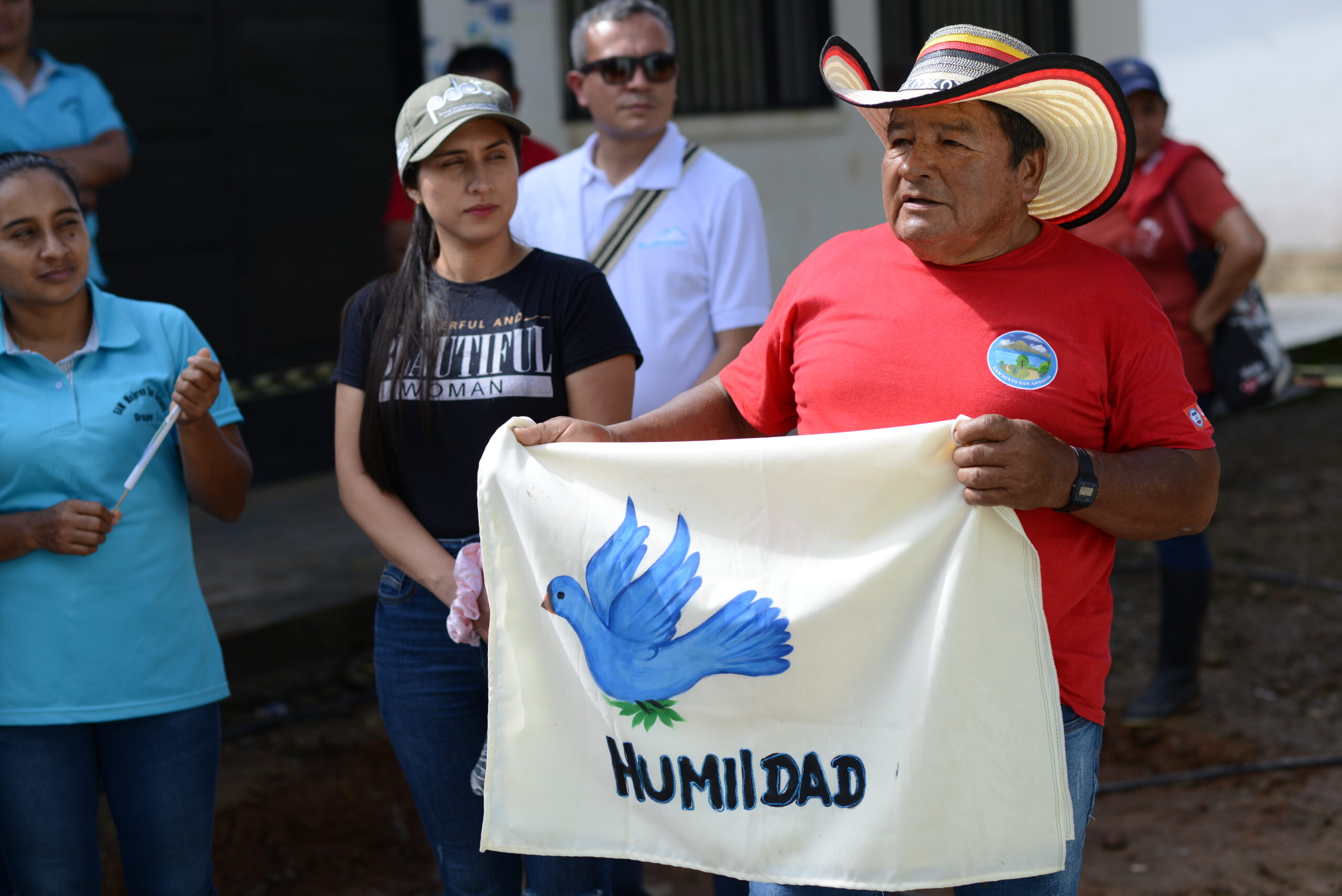
Innocencia (right), displayed the traditional shawl he designed in the mutual support group. He said, “We are never alone, we are together.”

